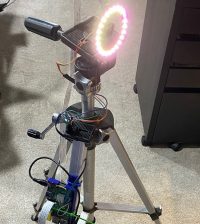- makeITcircular 2024 content launched – Part of Maker Faire Rome 2024Posted 2 weeks ago
- Application For Maker Faire Rome 2024: Deadline June 20thPosted 2 months ago
- Building a 3D Digital Clock with ArduinoPosted 7 months ago
- Creating a controller for Minecraft with realistic body movements using ArduinoPosted 7 months ago
- Snowflake with ArduinoPosted 8 months ago
- Holographic Christmas TreePosted 8 months ago
- Segstick: Build Your Own Self-Balancing Vehicle in Just 2 Days with ArduinoPosted 8 months ago
- ZSWatch: An Open-Source Smartwatch Project Based on the Zephyr Operating SystemPosted 9 months ago
- What is IoT and which devices to usePosted 9 months ago
- Maker Faire Rome Unveils Thrilling “Padel Smash Future” Pavilion for Sports EnthusiastsPosted 10 months ago
A DIY 3D Printing Filament Roller on Kickstarter
https://www.kickstarter.com/projects/522476987/filament-roller
How many times does your print stop for a filament error?
Now with this Filament Roller you have the chance to avoid any filament problem in printing process. It helps you to detect stoppages, automatically pause your printer, and alert you so you can diagnose your printer!
The Filament Roller uses a printed control wheel and infra-red sensors to detect movement from your filament. An on-board processor counts direction and speed so it can’t be fooled by retraction. It also doesn’t add any burden to your printer’s processor, no software modification required, and no software bugs!
An alarm timer is set using a small dial (3 to 48 sec.). A LED strobes for each change in position so you can tell if it is working at-a-glance. The alarm is triggered when no net movement is detected before the timer expires. An error signal output can be connected from the Filament Roller to your printer’s end-stop input (Marlin 1.1.x, RepRap) or OctoPrint (Filament Sensor Plugin, Raspberry Pi) to automatically pause your print! A 100 dB buzzer will alert you when your filament has stopped. The buzzer can be enabled or disabled using a switch.
The Filament Roller can be powered directly from your printer’s 5 volt supply all the way to a 24 volt external power supply.
The Filament Roller is designed as a stand-alone module, with its own internal logic, with a simple but complete interface, and a wide input voltage range so it can be used with almost any printer. It is flexible and totally open source. The mechanical designs are free to download and modify from Thingiverse so you can customize your sensor for your own printer!
If you like this project, support Christopher Robertson campaign on Kickstarter!














